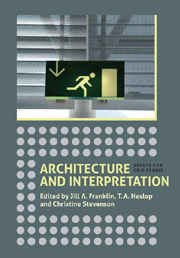Book contents
- Frontmatter
- Contents
- List of Illustrations
- Preface: In Appreciation
- List of contributors
- 1 Introduction
- Incitements to Interpret in Late Antique and Medieval Architecture
- 16 Believing is Seeing: The Natural Image in Late Antiquity
- 42 Articulation as an Expression of Function in Romanesque Architecture
- 60 Barrel-Vaulted Churches in Late Medieval Scotland
- 78 Augustinian and Other Canons' Churches in Romanesque Europe: The Significance of the Aisleless Cruciform Plan
- 99 Towers and Radiating Chapels in Romanesque Architectural Iconography
- 111 Diffusion, Imitation and Evolution: The Uncertain Origins of ‘Beakhead’ Ornament
- 128 Architecture and Pattern: The Western Façade of Lincoln Cathedral and Modernist Reference Points for its Interpretation
- Authors and Intentions
- Architecture beyond Building
- Index
128 - Architecture and Pattern: The Western Façade of Lincoln Cathedral and Modernist Reference Points for its Interpretation
from Incitements to Interpret in Late Antique and Medieval Architecture
Published online by Cambridge University Press: 05 April 2013
- Frontmatter
- Contents
- List of Illustrations
- Preface: In Appreciation
- List of contributors
- 1 Introduction
- Incitements to Interpret in Late Antique and Medieval Architecture
- 16 Believing is Seeing: The Natural Image in Late Antiquity
- 42 Articulation as an Expression of Function in Romanesque Architecture
- 60 Barrel-Vaulted Churches in Late Medieval Scotland
- 78 Augustinian and Other Canons' Churches in Romanesque Europe: The Significance of the Aisleless Cruciform Plan
- 99 Towers and Radiating Chapels in Romanesque Architectural Iconography
- 111 Diffusion, Imitation and Evolution: The Uncertain Origins of ‘Beakhead’ Ornament
- 128 Architecture and Pattern: The Western Façade of Lincoln Cathedral and Modernist Reference Points for its Interpretation
- Authors and Intentions
- Architecture beyond Building
- Index
Summary
ONE OF MY formative experiences as a student was listening to a lecture about the differences between Romanesque and Gothic figurative art, in which Eric Fernie invoked different styles of comic strips in order to reinforce the point that Romanesque art was about realism and Gothic art about naturalism. My strongest memory is of a comparison he made between the figure styles of Peanuts cartoons and sculpture by Gislebertus at Autun, when he showed how, through a common economy of means, both reached right to the essence of the emotions portrayed. By contrast, the greater descriptive and graphic detail of something like Barbarella, when compared with Gothic sculpture of Reims, indicated a different kind of concentration, more concerned with visual complexity and incident and more conventionally ‘natural’. This projection back from a contemporary genre seemed such an engaging method for investigating the past, especially as it operated as something like a pair of confronted mirrors, reflecting connections between past and present which illuminated both.
My theme here is, however, pattern, not figuration, or, more precisely, elements of continuity and contrast in the use of pattern in architecture in England between the twelfth and fourteenth centuries. I aim to explore to what extent different styles are indicative of differing aesthetic preferences in the Middle Ages, and how our understanding of such choices may be illuminated by comparing them with present-day values and interpretations.
- Type
- Chapter
- Information
- Architecture and InterpretationEssays for Eric Fernie, pp. 128 - 144Publisher: Boydell & BrewerPrint publication year: 2012



